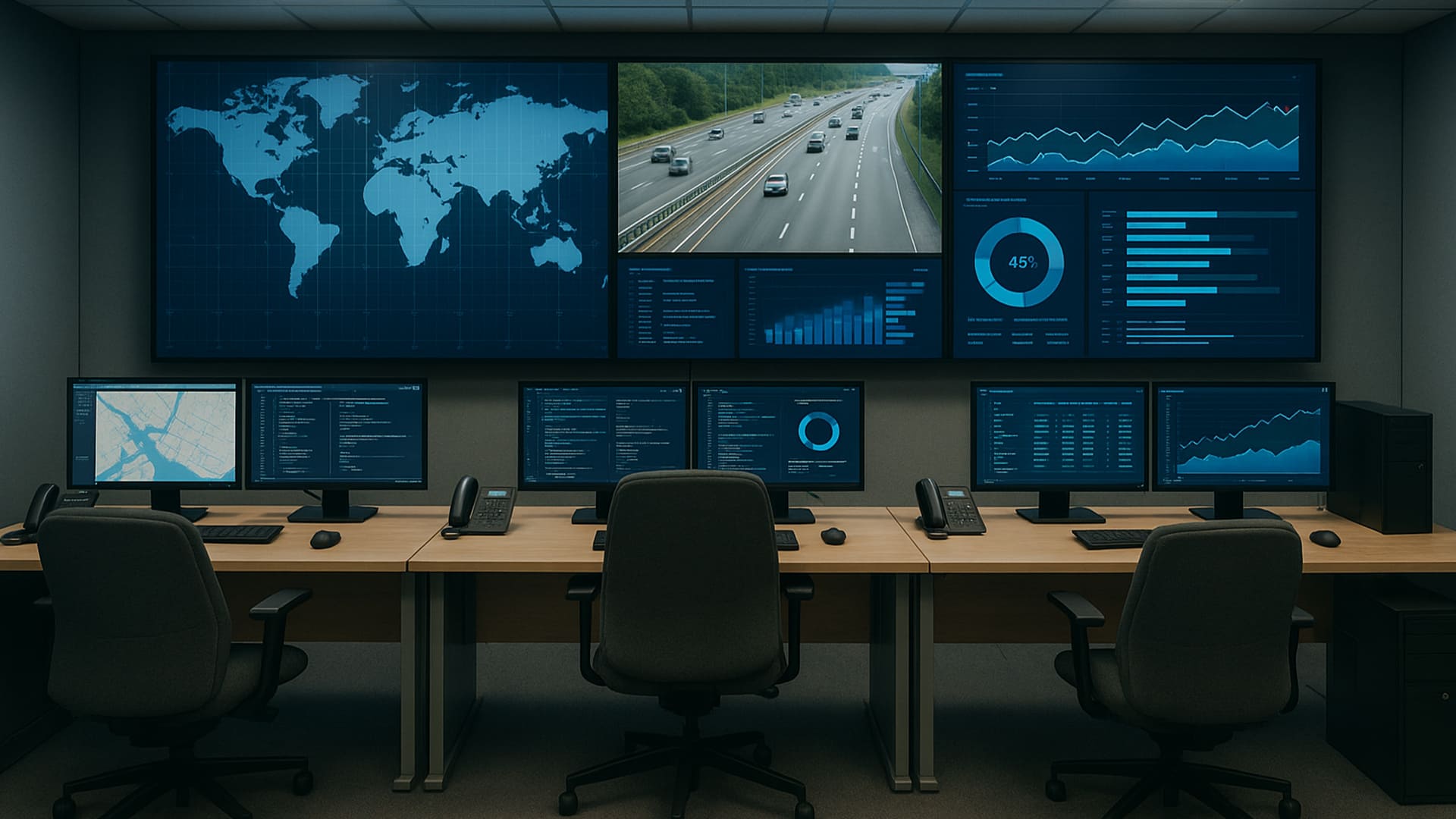Once defined by rows of monitors and the hum of CRT screens, the command and control centre has evolved into the very core of modern decision-making. From defence missions to city grids, from IT networks to corporate campuses, these spaces are now synonymous with real-time awareness and operational resilience.
In today’s world of connected systems and high-speed data, command centres have become strategic instruments, turning raw information into informed action. They don’t just see the world; they sense it. Whether it’s rerouting a flight network, monitoring a cyber-attack, or coordinating emergency response, these centres have redefined how institutions stay in control amid complexity.
The early command centres were largely functional, large rooms lined with independent monitors and analog communication tools. But as data streams multiplied, so did the need for synthesis. Today’s command environments fuse architecture, data, and interaction, creating spaces that think as much as they display.
The foundation of the modern command centre lies in situational awareness, integrating feeds from hundreds of cameras, sensors, and communication networks into one unified platform. The focus is not on showing more data, but on showing the right data in the right way. The challenge lies in presenting this overwhelming amount of information in a way that enables quick, accurate decision-making rather than creating confusion.
What was once reactive has become predictive. Artificial intelligence and analytics tools now allow teams to anticipate incidents rather than merely respond to them. These are no longer watch rooms, they are decision engines that help organizations stay ahead of problems before they escalate into crises.
The sophistication of technology has been matched by the rise of human-centric design. The control room is no longer a dark, fatiguing bunker but an ergonomically tuned environment that sustains focus and efficiency over 24-hour cycles.
Every aspect, from tiered seating geometry and eye-level calibration to lighting balance and acoustic absorption, is designed to ensure precision and comfort. The result is a setting where teams can act with speed and clarity, even under immense pressure.
As design consultants emphasize, a command centre succeeds when it amplifies human judgment, not when it overwhelms it. Technology and architecture must operate as one coherent organism, both intelligent and intuitive.
Behind the displays and bright LED walls is a sophisticated network of systems. High-speed servers, redundant processors, and network matrices form the foundation. These backend systems must handle massive data throughput while maintaining zero-tolerance for failure.
The shift to AV-over-IP has revolutionized these systems. Unlike traditional hardwired setups, IP-based networks allow seamless scalability, letting integrators route hundreds of feeds over a unified digital fabric with negligible latency. Traditional matrix switchers had physical limitations, you could only add so many input and output cards within a fixed frame. But with network-based routing, the possibilities become virtually unlimited.
War rooms and collaboration zones now extend from the main control floor, enabling teams to isolate crises, conduct reviews, and deploy rapid responses, all without interrupting ongoing operations. Resilience is designed in: power redundancy, failover systems, and data backups ensure that even in failure, the command never falters. This is not just technology, it’s continuity by design.

Founder and Principal Consultant at MetaHive Design Consulting
For Raguvaran, Founder and Principal Consultant at MetaHive Design Consulting, command centres are a blend of precision and purpose. Having designed mission-critical facilities for ISRO, ADA, and Wipro, he has watched the technology curve transform dramatically.
“Two decades ago, command centres ran on rear-projection modules, massive enclosures with projectors at the back. That was state-of-the-art during Chandrayaan-2,” he recalls. “Now it’s all 4K LED walls and LFD arrays, which are modular and seamless.” But for him, the evolution isn’t just visual, it’s architectural. “We design for use-case, not just aesthetics. If the client needs to monitor hundreds of camera feeds, a well-calibrated LFD setup may outperform an LED wall.”
Raguvaran also highlights the AV-over-IP revolution, “Traditional matrices had physical limits. With IP-based routing, scalability is infinite. A thousand inputs can flow through a network switch instead of a hardware cage.” He explains the practical benefits: “Instead of a large matrix with limited slots, you can leverage network switches. It’s unlimited scalability and costs about half of traditional systems. Plus, for extension, the encoders act like extenders themselves, sending signals via IP through CAT6 cables.” The beauty of this system is that a simple CAT6 cable can extend signals up to 100 meters, and for longer distances, fiber optic options are available.
Raguvaran recollects that “during Chandrayaan-2, ISRO’s command centre still used rear-projection technology. Those were 130-inch modules, state-of-the-art for their time. Now everything is modular, seamless, and far more efficient.” He cautions, though, against blind adoption. “Technology has to justify its purpose. A command centre must be designed for decision-making, not for show. I’ve done over 200 command centres, and I’ve seen clients reverse their decision on LED walls after understanding the use case. If you need to see more images at once, LED walls aren’t always the right solution.”
Raguvaran emphasizes the importance of understanding the actual requirements: “The biggest mistake is designing without knowing how critical the information is and what kind of decisions will be made. That defines the entire scale of your command centre. Even if a client has a big budget, it doesn’t mean they need an LED wall, as it might be the wrong solution considering the functionality against the lavish looks.”
Looking ahead, he sees the rise of virtual command spaces: “Decision-makers can soon access their command wall remotely, interactively, without stepping into the room. You can bring all your feeds into a simple desktop screen virtually. That’s the next frontier.”

Managing Director at AVFx Solutions
Pramod DP, Managing Director at AVFx Solutions, brings the integrator’s perspective, ensuring what’s designed actually delivers in the field. “The biggest challenge,” he explains, “is understanding what the client really needs. Many start without clarity, so we guide them through demos until they see how a command system works, by educating them and giving multiple options until they understand what they actually want.” For him, the key is redundancy, the silent hero of reliability. “Every mission-critical centre we build has dual power, dual processors, dual networks. Even the video processor has a carbon-copy backup that takes over in milliseconds. These command centres have to run 24 hours without any interruption. Any downtime costs the users heavily, so we go for redundancy in everything possible.”
Pramod sees the future in 10-Gig SDVoE-based AV-over-IP systems: “They merge video, KVM, and USB control into a single network fabric. That’s simplicity meeting scalability. Everything, video, keyboard, mouse, USB peripherals, is captured in one single box at 10 gigabits. This is something that’s really booming right now.”
The technology advancement has been remarkable. From handling basic video feeds, systems now process 4K content with high frame rates, requiring sophisticated network infrastructure. “An uncompressed 4K video feed requires 18 Gbps of bandwidth,” Pramod explains. “When you’re dealing with hundreds or thousands of camera feeds, the network infrastructure becomes critical. But with compression technologies and smart routing, we can manage thousands of feeds efficiently.”
He believes that clients now recognize command centres as operational investments. “Earlier, people were hesitant to invest much in command centres. But now people understand the importance of having a large screen with data. You cannot put all that data on a small screen, and multiple people cannot use it effectively. People are understanding the need, and that’s why this is a growing space.”
According to Dhiraj Kumar, Project Head at Multee Proe India, the momentum for high-end command centres in India has never been stronger. “It’s becoming a mandatory infrastructure for every large organization across IT, government, military, transportation, and enterprise,” he notes.

Project Head at Multee Proe India
Dhiraj believes that the core value of a command centre lies in its unification of information. “It integrates data from sensors, cameras, communications, and databases into one cohesive platform. This helps reduce information overload and gives decision-makers real clarity. Real-time dashboards and visualizations enable quick understanding of complex situations, helping people focus on what matters most.”
For him, these environments are not just about visibility, they’re about coordination. “During a crisis, a command centre becomes the single point of truth. Integrated audio-video systems and shared data walls create collaboration between departments, improving clarity and action. Multiple departments can work together in one space, physically or virtually, and that improves teamwork tremendously.”
Dhiraj stresses that modern clients now seek technological convergence, tying together security, logistics, IT, IoT, GIS, and emergency systems into one interface. “Customers are looking at integration of technology with their existing work areas. The proposed command centres can be integrated with multiple working platforms and bring them into a single command interface. This reduces replication of data and ensures consistency of information across the organization.”
He also emphasizes the security architecture behind these systems. “Centralized monitoring enhances threat detection. Secure networks and access controls protect sensitive data and mission-critical operations. These centres are designed with redundancy, backup power, and failover systems to ensure continuous operation during a crisis, whether cyber, physical, or operational.”
As organizations scale, he sees the rise of cloud-based, remotely accessible command centres that offer both daily operational insight and long-term strategic intelligence. “Modern command centres support cloud-based or remote operation, allowing decentralized teams to connect securely. Scalable systems grow with organizational needs. A world-class command centre supports both daily operations and long-term strategic planning.”
Closing Note
From projection modules to 4K video walls, from manual oversight to AI-driven foresight, the command and control centre has transcended its origins. It is now the architectural embodiment of awareness, a space where design, data, and human insight converge.
What emerges from these conversations is a clear truth: technology alone does not make a command centre successful. It’s the thoughtful integration of use-case understanding, redundant architecture, and human-centric design that creates spaces capable of making critical decisions under pressure.
Whether it’s Raguvaran’s emphasis on purpose over aesthetics, Pramod’s focus on bulletproof reliability, or Dhiraj’s vision of unified intelligence, all three perspectives converge on one principle: a command centre must serve the decision-maker first, rather than looking impressive.
As technology continues to evolve—with virtual interfaces, cloud connectivity, and AI-driven analytics – one truth endures: the strength of any organization lies in its ability to see clearly, decide wisely, and act swiftly. That is the very promise that every command centre fulfills.





